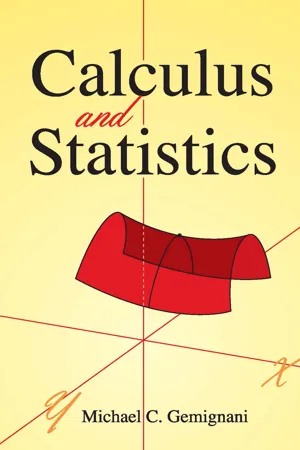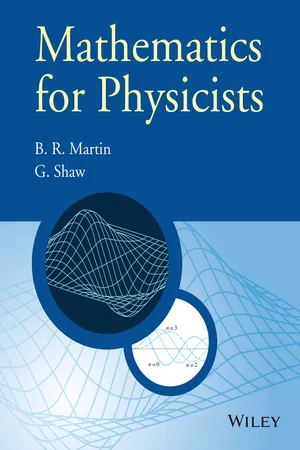Mathematics
Integration Tables
Integration tables are a tool used in calculus to help solve integrals. They provide a list of common integrals and their corresponding solutions, making it easier to solve more complex integrals by breaking them down into simpler parts. Integration tables are a useful resource for students and professionals alike.
Written by Perlego with AI-assistance
Related key terms
3 Key excerpts on "Integration Tables"
- eBook - ePub
- Michael C. Gemignani(Author)
- 2014(Publication Date)
- Dover Publications(Publisher)
One important method of integration we have not yet considered is the use of tables of integrals. Compared to most calculus texts, this text presents very few methods of integration. We have not, for example, considered integration by partial fractions or the use of trigonometric transformations. There are good reasons for limiting our consideration of integration techniques. First, the integrals the reader will encounter in practical situations, particularly in statistics, are rarely cooperative enough to be readily evaluated using neat integration techniques. Second, the memory of human beings is limited; to use our memory to its best advantage, we should learn those things we will need most often and only know where to locate, if the need arises, those things we hardly use at all. To utilize our memory most efficiently, we shall omit most integration techniques in favor of material that we shall need more frequently. Third, “Tables of Integrals” have been compiled to aid integration. Why spend time deriving what can be looked up rather quickly?A short table of integrals is given on the endpaper at the back of this text; more complete tables are available in various handbooks. In order to use a table of integrals, we must match the integral we wish to evaluate with the appropriate integral in the table. To obtain such a match a change of variable may be necessary. The following examples illustrate the use of a table of integrals.Example 25. ConsiderLooking through the table of integrals for something which resembles (53 ), we encounterLetting x = u and a = 2, we see that (54 ) becomes the appropriate indefinite integral for evaluating (53 ). Thus, (53 ) is equal toExample 26. ConsiderIn the table of integrals, we findwhere (x) is the so-called Gamma function. Thus, (55 ) is (4). Tables of values of (x) are found in most handbooks of probability and statistics.Example 27. ConsiderThere is no integral in the table of integrals which looks exactly like (57 ). However, if we let u = 3x2 – 1, then du = 6x dx, and, in terms of u, (57 ) becomesWe can now use the indefinite integral sin2 u du found in the table to evaluate (58 ).This text does not include much material on the trigonometric functions (sine, cosine, tangent, etc.) or inverse trigonometric functions (sin–1 (sometimes denoted by arcsin), cos–1 , etc.), for three reasons: (1 ) it is assumed that the reader has already studied these functions in previous courses; (2 ) these functions are not encountered very often in work with probability and statistics; and (3 - eBook - ePub
- Alan Jeffrey(Author)
- 2004(Publication Date)
- Chapman and Hall/CRC(Publisher)
8Systematic integration
To make effective use of integration it is necessary to develop a systematic approach to the integration of standard forms of integral. This is accomplished in this chapter, which discusses integration by substitution, integration by parts, the use of reduction formulae and the use of partial fractions to simplify the task of integrating rational functions. It is shown how these same techniques may be used to find antiderivatives (indefinite integrals) which are just functions, and definite integrals which are numbers. The chapter ends with a discussion of differentiation under the integral sign and the integration of trigonometric functions involving multiple angles.8.1 Integration of elementary functions
The main objective of this chapter is to explore some of the systematic methods for determining an antiderivative , that is, a function F(x) whose derivative is equal to some given function f(x). As described in the previous chapter, we shall denote the antiderivative of the function f by∫ fwith the understanding that( x )d x∫(8.1)f( x )d x = F( x )+ Cwith C an arbitrary constant.Alternatively, as any indefinite integral of f must also be an anti-derivative of f , we may identify F(x) in Eqn (8.1) withdy , where a is arbitrary, and incorporate the constant C into the constant resulting from the arbitrary lower limit to obtain the equivalent expression∫ a xf( t )∫(8.2)f( x )dx =∫ a xf( t )d t .Remember that the symbol∫ fis derived from differentiation and denotes the most general function whose derivative is f . The allied symbol( x )d xdenoting a definite integral of f , derives from integration and is simply a real number.∫a ˙bf( x )d x - eBook - ePub
- Brian R. Martin, Graham Shaw(Authors)
- 2015(Publication Date)
- Wiley(Publisher)
They are often useful for integrals where the integrand can be written as the product of two terms, at least one of which can be easily integrated. For example, consider the integral On setting u = x and, (4.33a) gives, Integration by parts is also sometimes useful to integrate functions that can be differentiated to give simpler functions. For example, so that (4.33a) gives Finally, it can also be used to derive relations, called reduction formulas (also called recurrence relations), between families of integrals I n whose members are characterised by an integer n. For example, consider the integrals Then i.e. This is a typical reduction formula, enabling I n to be evaluated in terms of I n − 1, and hence by repeated application, I n for any n to be found, starting from Although we have shown that reduction formulas can be obtained using integration by parts, they can sometimes be obtained in other ways, as illustrated in Example 4.12 below. Example 4.11 Integrate the following functions by parts: Solution The integral is Integrating the last term by parts, using u = cos x and, then gives so that The integral is where we have integrated by parts using and. Then writing in the integral gives so that where we have used a standard integral from Table 4.2. Example 4.12 If show that and find I 4. Solution This relation is found by forming I n + 2 from the definition, i.e. To find I 4 we start from Then, and finally 4.5 Numerical integration In practice, one often needs to evaluate the definite integral (4.9) for functions f (x) where an explicit form for the corresponding indefinite integral (4.6) cannot be found. In these cases, one must resort to a numerical evaluation, usually with the aid of a computer. There are many methods available for doing this. Here we shall consider only the two simplest, which are based on dividing the integral into strips, as shown in Figure 4.4, Section 4.4.2
Learn about this page
Index pages curate the most relevant extracts from our library of academic textbooks. They’ve been created using an in-house natural language model (NLM), each adding context and meaning to key research topics.


